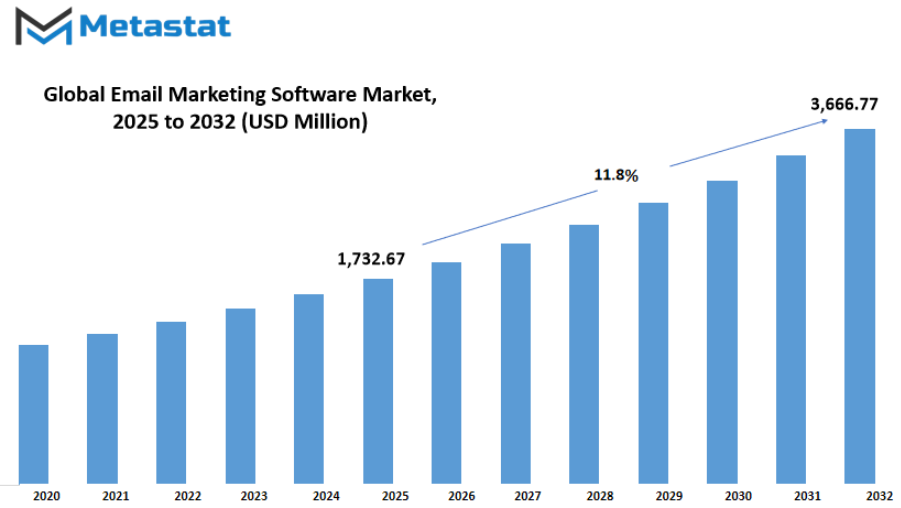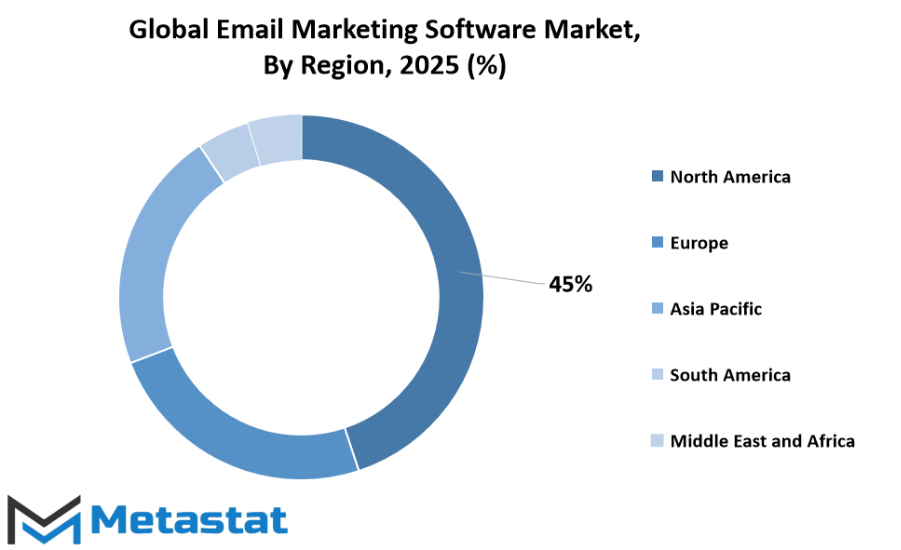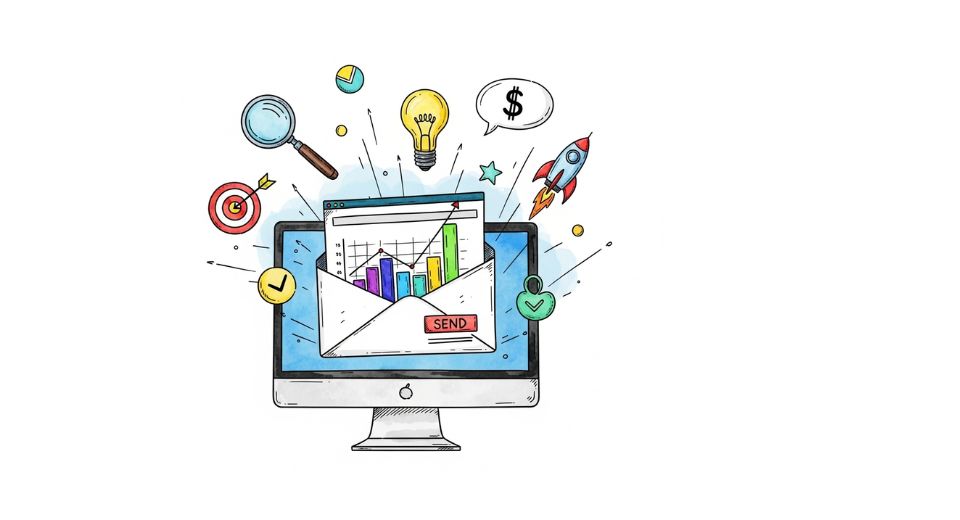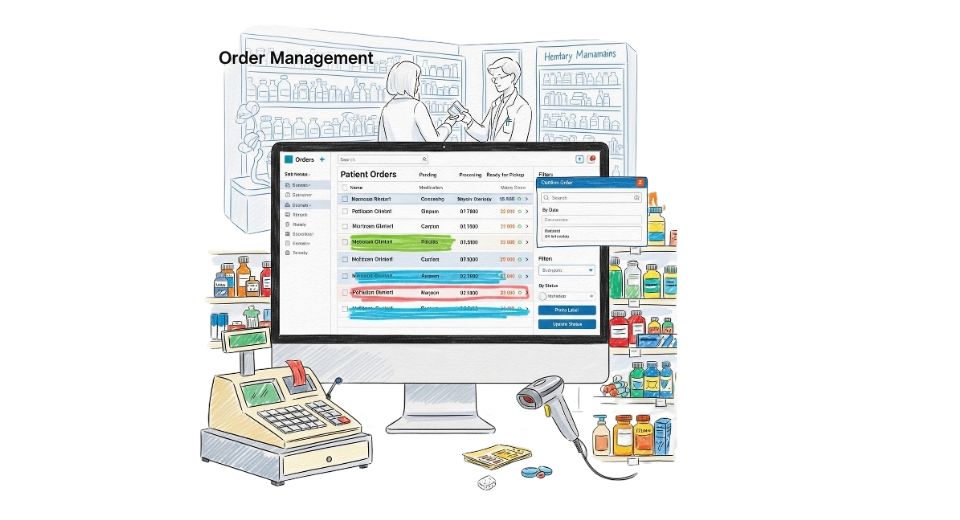MARKET OVERVIEW
The global email marketing software market will be a core part of the global communication market, being the support system for how companies are going to reach out to consumers globally. This market basically includes tools and solutions that allow organizations to create, send, and monitor email campaigns with accuracy and quickness. While the medium of email has existed, how software will influence its delivery, personalization, and tracking will determine its future relevance. Small and large companies alike will increasingly be depending on such platforms to create segmented messages that will reach their intended listener at the optimal time.
Unlike the other online marketing solutions based on social interaction or search visibility, email marketing software will offer a physical and measurable medium. Software will enable advanced analytics, segmentation, and automation capabilities that will customize communication. To global brands, it will no longer be a question of distributing marketing communications; it will be one of delivering content that is customized and speaks to different linguistic and cultural segments of individuals. This focus on individualization will raise the value of the market to organizations wanting to develop long-term customer relationships.
The global email marketing software market will not be confined to campaign construction software. It will expand into categories that will encompass AI-based content generation, predictive analytics, and effortless integration with customer relationship management systems. This will lead to the software acting as a bridge between marketing strategy and actionable customer insights. Companies will use it to predict consumer behavior, dynamically adjust messaging in real time, and bring coherence across digital channels.
One of the traits of this marketplace will be its responsiveness. As privacy laws continue to get more stringent and consumer attitude is transformed, email marketing software will evolve to deliver data security, permission, and compliance. Merchants will center on building their software such that it enables open communication but also provides marketers measurable results. This crash of personalization and privacy will become one of the hallmarks of the industry, challenge and opportunity.
In the years to come, Global Email Marketing Software will also experience convergence with other marketing technology. Instead of standing alone, email marketing platforms will become integrated with social media, e-commerce websites, and customer data platforms. This convergence will enable companies to coordinate campaigns that transition smoothly from one channel to another such that email becomes one of the touchpoints in a larger digital campaign.
As digital evolution continues to redefine world business practices, the position of this marketplace will become increasingly pivotal. The software will help marketers stay in constant voice, responding to changing market dynamics, and connecting to people who will find both personal and pertinent. Through this means, the global email marketing software market will do more than facilitate communication—it will determine how businesses will forge relationships, foster trust, and provide measurable results in an interconnected world.
Global email marketing software market is estimated to reach $3,666.77 Million by 2032; growing at a CAGR of 11.8% from 2025 to 2032.

GROWTH FACTORS
The global email marketing software market is expected to see steady expansion in the coming years, supported by shifts in how businesses approach digital outreach. One of the main reasons for this growth is the rising need for affordable marketing tools that can effectively target specific audiences. Businesses of all sizes are seeking solutions that allow them to maximize returns while keeping costs in check, and email marketing continues to be one of the most cost-efficient options available. It enables direct communication with potential and existing customers, making it highly attractive for organizations aiming to strengthen customer relationships without large advertising budgets.
A second major factor driving the global email marketing software market is the increasing adoption of automation and artificial intelligence. These technologies are changing the way campaigns are designed, delivered, and analyzed. Automation saves time by streamlining repetitive tasks such as scheduling, segmentation, and follow-ups, while AI helps create more personalized content by learning from user behavior and preferences. This means businesses can send highly relevant messages to different audience segments, improving engagement rates and campaign success. Over time, these tools will become even more advanced, providing marketers with the ability to predict customer actions and respond instantly with tailored offers.
Despite the growth potential, there are challenges that could slow market progress. Data privacy regulations are becoming stricter across different regions, forcing businesses to adapt quickly to comply with rules regarding consent and information handling. At the same time, spam filters and compliance standards make it harder for marketing emails to reach their intended recipients. Additionally, the market faces intense competition from multi-channel marketing platforms that combine email with social media, SMS, and other forms of outreach. This competition can make it difficult for standalone email software providers to maintain their market share.
Looking ahead, there are clear opportunities for innovation. Integrating AI-driven analytics and predictive insights will allow companies to create hyper-personalized campaigns that go beyond basic segmentation. Future systems may be able to anticipate customer needs before they are even expressed, sending messages that feel timely and relevant in a way that increases loyalty and sales. This kind of predictive capability could become a standard feature, giving businesses a competitive edge and helping them cut through the noise of a crowded digital space. As technology continues to improve, Global Email Marketing Software will likely play an even greater role in helping companies connect with their audiences in smarter, more efficient ways.
MARKET SEGMENTATION
By Channel
The global email marketing software market has become a vital tool for businesses seeking to connect with their audience more effectively. As technology continues to progress, the way companies use email is transforming. The market for such software is not only growing in size but also in sophistication, with the ability to personalize messages, track engagement, and automate campaigns. Businesses are no longer sending out generic bulk emails; instead, they are creating targeted and meaningful content that speaks directly to the interests and needs of their recipients. This shift is driven by the increasing demand for results-oriented communication, where every email has a clear purpose and measurable outcome.
By channel, the global email marketing software market is further segmented into B2B and B2C, each serving different needs. In the B2B segment, the focus is on building strong, long-term relationships with other companies. Here, email campaigns often share in-depth insights, industry reports, and updates that help clients make informed decisions. The communication is usually professional, informative, and aimed at establishing trust over time. On the other hand, the B2C segment prioritizes engaging with individual customers in a more direct and emotional way. These campaigns might highlight new product launches, special offers, or personalized recommendations based on previous purchases. In both cases, the success of the strategy depends on understanding the audience and delivering value with every message.
The global email marketing software market will become even more intelligent and adaptive. Artificial intelligence and predictive analytics will play a key role, allowing businesses to anticipate customer needs before they are even expressed. Imagine software that not only schedules and sends emails but also learns from each interaction, refining its approach for maximum impact. This could mean higher open rates, better click-through rates, and ultimately, stronger customer loyalty. Integration with other digital tools will also become seamless, enabling marketers to manage entire campaigns from a single platform.
Privacy and data protection will remain important considerations. As regulations become stricter, companies will need to ensure that their software complies with all legal requirements while still delivering effective marketing. Transparency in how customer data is collected and used will build trust, which is essential for long-term success.
In the coming years, the global email marketing software market will not just be about sending messages—it will be about creating ongoing conversations. Businesses that adapt to this approach, whether in B2B or B2C channels, will be better equipped to connect with their audience, drive engagement, and stay ahead in a competitive market. This evolution will make email not just a marketing tool, but a strategic asset for growth.
By Deployment
The global email marketing software market is shaping the way businesses connect with their audience, and its influence will continue to grow in the years ahead. As technology moves forward, companies are seeking faster, more efficient, and more personal ways to reach customers, and email remains one of the most direct channels for communication. Unlike many other tools, email allows businesses to tailor messages based on customer preferences, past behavior, and purchase history, making it a powerful method for building trust and long-term relationships.
The global email marketing software market will see even more automation and smarter targeting, supported by artificial intelligence and machine learning. These technologies will help brands send the right message at the right time, ensuring better engagement rates and customer satisfaction. Personalization will not only focus on using a customer’s name but will also adapt to their habits, needs, and even predicted future actions. Businesses will be able to create campaigns that feel like one-on-one conversations rather than mass messages.
By deployment, the global email marketing software market is divided into cloud-based and on-premise solutions. Cloud-based options will continue to dominate because they are flexible, easy to update, and accessible from anywhere, making them ideal for businesses of all sizes. They allow teams to work remotely, integrate with other online platforms, and scale quickly as the business grows. On-premise software, however, will still have a place, particularly for organizations that require strict control over their data and security. While it may involve higher upfront costs and maintenance, it offers a level of customization and data handling that some companies find essential.
In the future, cloud-based systems will likely incorporate more real-time analytics, enabling marketers to adjust campaigns instantly based on performance data. On-premise systems may evolve with stronger encryption and advanced data protection features, ensuring compliance with tightening global privacy laws. Both deployment types will benefit from innovations in design tools, allowing even small businesses to create visually appealing and interactive email content without requiring specialist skills.
The growing importance of mobile devices will also influence how Global Email Marketing Software develops. More customers open and read emails on their phones, so software will focus on optimizing layouts, images, and interactive features for smaller screens. This will not just be about making emails look good on mobile but ensuring they are easy to read, quick to load, and simple to act on.
The global email marketing software market will not just be about sending messages but about creating a seamless, personalized experience that connects brands and customers in meaningful ways. As new technologies appear, these tools will keep adapting, ensuring businesses can communicate effectively in a fast-changing digital world.
By Enterprise Size The global email marketing software market is expected to grow steadily as more businesses recognize the importance of direct communication with customers. In the future, email will continue to be one of the most cost-effective channels for reaching audiences, regardless of industry. This software allows companies to send targeted messages, track engagement, and adjust campaigns in real time. As technology advances, these tools will become even smarter, offering predictive analytics and AI-driven personalization to improve customer experiences. Businesses that adopt these features early will be able to stay ahead of their competition.
By enterprise size, the global email marketing software market is often divided into SMEs and large enterprises, each with different needs and approaches. SMEs generally look for affordable, easy-to-use solutions that do not require large technical teams. Many of these smaller companies value automation features that save time and reduce manual work. For them, the focus is often on growing their customer base and building brand awareness through simple, effective campaigns. In contrast, large enterprises usually need advanced tools that can handle massive amounts of data, integrate with other systems, and support global operations. These businesses often prioritize security, scalability, and compliance with international regulations.
Looking ahead, the global email marketing software market will likely include even more advanced segmentation tools, allowing businesses to create highly specific audience groups based on behavior, location, and purchase history. This level of precision will help companies connect with customers in a more personal way, which will improve engagement and loyalty. Another likely development is the integration of these platforms with other communication channels, so businesses can manage all customer interactions in one place.
Automation will continue to be a major driver of adoption, especially as AI tools learn to predict the best times to send messages, the types of content most likely to get responses, and even the tone that works best for specific groups. In the long term, this could lead to campaigns that adapt themselves in real time based on how recipients interact with them.
Data privacy will also shape the future of this market. As regulations become stricter, software providers will need to offer built-in compliance features that make it easier for businesses to follow the rules. This will be important for both SMEs and large enterprises, but the scale of implementation will differ.
Overall, the global email marketing software market will continue to be a key tool for businesses of all sizes. Its ability to adapt, personalize, and integrate with other technologies will ensure its relevance for years to come, driving stronger connections between companies and their customers.
By Application
The global email marketing software market is expected to play a bigger role in the way businesses connect with their customers in the future. As companies continue to expand their online presence, the demand for tools that allow effective communication will grow. This software will help organizations reach audiences quickly, personalize messages, and track the success of campaigns with precision. Its importance will only increase as businesses look for better ways to stand out in a crowded digital space.
By application, the global email marketing software market will be divided into several important areas. Email Lead Generation will remain a major use, helping companies find and connect with potential customers more efficiently. With advanced targeting and automation, businesses will be able to identify the right audience and send relevant messages at the right time. This will save time while improving the chances of turning leads into long-term customers.
Sales Reporting will also benefit greatly from future improvements. Companies will be able to access real-time data about their sales performance, allowing them to make quick adjustments to strategies. This level of insight will help managers understand which campaigns work best and where improvements are needed. The ability to instantly measure results will give businesses an advantage in responding to market changes.
Customer Management will become even more powerful, allowing organizations to build stronger relationships with their audience. Future software will likely offer more advanced ways to track customer behavior, preferences, and past interactions. This will allow for highly personalized communication, making customers feel valued and more likely to remain loyal.
Template Management will make creating professional and appealing emails easier than ever. Companies will have access to a wide range of designs that can be customized without technical skills. In the future, these templates will adapt automatically to different devices and user preferences, ensuring a smooth experience for recipients.
Reporting and Analytics will continue to be a driving force behind decision-making. Businesses will be able to see not only how many people opened an email but also how they interacted with it. This information will help in fine-tuning campaigns and predicting what might work in the future.
Other applications will also emerge as technology advances. These could include AI-driven personalization, advanced segmentation, and integration with other marketing platforms. As the capabilities of Global Email Marketing Software expand, it will become an even more essential tool for businesses that want to remain competitive and build lasting connections with their customers in the digital age.
|
Forecast Period |
2025-2032 |
|
Market Size in 2025 |
$1,732.67 million |
|
Market Size by 2032 |
$3,666.77 Million |
|
Growth Rate from 2025 to 2032 |
11.8% |
|
Base Year |
2024 |
|
Regions Covered |
North America, Europe, Asia-Pacific Green, South America, Middle East & Africa |
REGIONAL ANALYSIS
The global email marketing software market is set to grow steadily as businesses across the world continue to prioritize direct and personalized communication with their customers. This software has already proven its value in helping companies reach targeted audiences, automate campaigns, and track results efficiently. As technology advances, it is expected that new features such as advanced AI-driven analytics, deeper personalization, and seamless integration with other digital tools will shape the way organizations approach customer engagement.
Based on geography, the global email marketing software market is divided into several key regions, each with its own unique opportunities. In North America, which includes the U.S., Canada, and Mexico, adoption rates are already high, but future growth will likely focus on innovation and automation to improve efficiency. The region’s strong digital infrastructure and competitive business environment will drive demand for software that can provide faster campaign deployment and more accurate performance insights.
Europe, consisting of the UK, Germany, France, Italy, and the Rest of Europe, will continue to be a significant market due to its diverse range of industries and growing emphasis on data privacy regulations. These regulations will encourage software providers to develop tools that ensure compliance while still delivering effective marketing strategies. This will open doors for solutions that can balance creativity with legal requirements, especially in cross-border marketing efforts.
In the Asia-Pacific region, including India, China, Japan, South Korea, and the Rest of Asia-Pacific, rapid digital adoption and the expansion of e-commerce are creating strong demand for email marketing solutions. Businesses in these countries are likely to focus on scalability and multilingual capabilities to connect with diverse consumer bases. With a young, tech-savvy population and increasing internet penetration, the potential for market growth in this region is substantial.
South America, covering Brazil, Argentina, and the Rest of South America, will benefit from growing internet access and the rise of small and medium-sized enterprises seeking affordable yet effective marketing tools. The Middle East & Africa, which includes GCC Countries, Egypt, South Africa, and the Rest of Middle East & Africa, will likely see adoption driven by digital transformation initiatives and the need for software that supports mobile-first strategies due to the high rate of smartphone usage.
As the demand for the global email marketing software market, providers that can adapt their solutions to meet regional needs, incorporate emerging technologies, and maintain user-friendly interfaces will be best positioned to succeed in the future digital marketplace.

COMPETITIVE PLAYERS
The global email marketing software market is moving toward a future where personalization, automation, and integration will define how businesses connect with their audiences. As digital communication continues to grow in importance, companies are investing more in tools that not only send emails but also track engagement, segment audiences, and provide detailed analytics. These advancements are giving businesses the ability to deliver more relevant messages at the right time, increasing customer loyalty and conversion rates. In the coming years, the focus will likely shift even more toward AI-driven recommendations, predictive targeting, and seamless integration with other marketing channels.
In this competitive space, major players are shaping the future of the industry through innovation and strategic growth. Oracle Corporation and Salesforce, Inc. are leveraging their strong technology ecosystems to offer marketing solutions that connect with broader business operations. HubSpot, Inc. continues to expand its platform to serve both small and large enterprises with flexible tools that simplify campaign creation. Campaign Monitor and Constant Contact, Inc. remain popular choices for their ease of use and strong templates, making them accessible for smaller businesses looking to run professional campaigns without complex setups.
Klaviyo is making a name for itself by offering advanced segmentation and automation features, particularly for e-commerce brands. Benchmark Internet Group, LLC and Mailjet SAS are focusing on providing user-friendly interfaces combined with powerful analytics, appealing to companies seeking a balance between simplicity and functionality. ActiveCampaign, LLC stands out for its deep automation workflows that blend email marketing with customer relationship management, while Brevo is pushing forward with tools that enhance engagement across multiple channels. GetResponse Sp. z o.o. continues to evolve with webinars and conversion funnels built directly into its platform, giving marketers more options without relying on separate tools. SendGrid, Inc. has a strong reputation for its robust delivery infrastructure, making it a go-to for businesses sending high volumes of emails. Zoho offers integration with its wide range of business software, making it a convenient choice for existing users, while SendX positions itself as an affordable, feature-rich option for growing businesses.
Looking ahead, the competition among these companies will likely intensify as demand for more intelligent, data-driven solutions rises. Businesses will expect platforms to not only manage campaigns but also predict customer behavior, adapt to privacy regulations, and deliver measurable returns. The future of the global email marketing software market will be shaped by the ability of these key players to innovate, meet evolving customer needs, and maintain trust in an increasingly data-conscious world.
Email Marketing Software Market Key Segments:
By Channel
- B2B
- B2C
By Deployment
- Cloud-based
- On-premise
By Enterprise Size
- SMEs
- Large Enterprises
By Application
- Email Lead Generation
- Sales Reporting
- Customer Management
- Template Management
- Reporting and Analytics
- Others
Key Global Email Marketing Software Industry Players
- Oracle Corporation
- Salesforce, Inc.
- HubSpot, Inc.
- Campaign Monitor
- Constant Contact, Inc.
- Klaviyo
- Benchmark Internet Group, LLC
- Mailjet SAS
- ActiveCampaign, LLC
- Brevo
- GetResponse Sp. z o.o.
- SendGrid, Inc.
- Zoho
- SendX
WHAT REPORT PROVIDES
- Full in-depth analysis of the parent Industry
- Important changes in market and its dynamics
- Segmentation details of the market
- Former, on-going, and projected market analysis in terms of volume and value
- Assessment of niche industry developments
- Market share analysis
- Key strategies of major players
- Emerging segments and regional growth potential








 US: +1 3023308252
US: +1 3023308252






